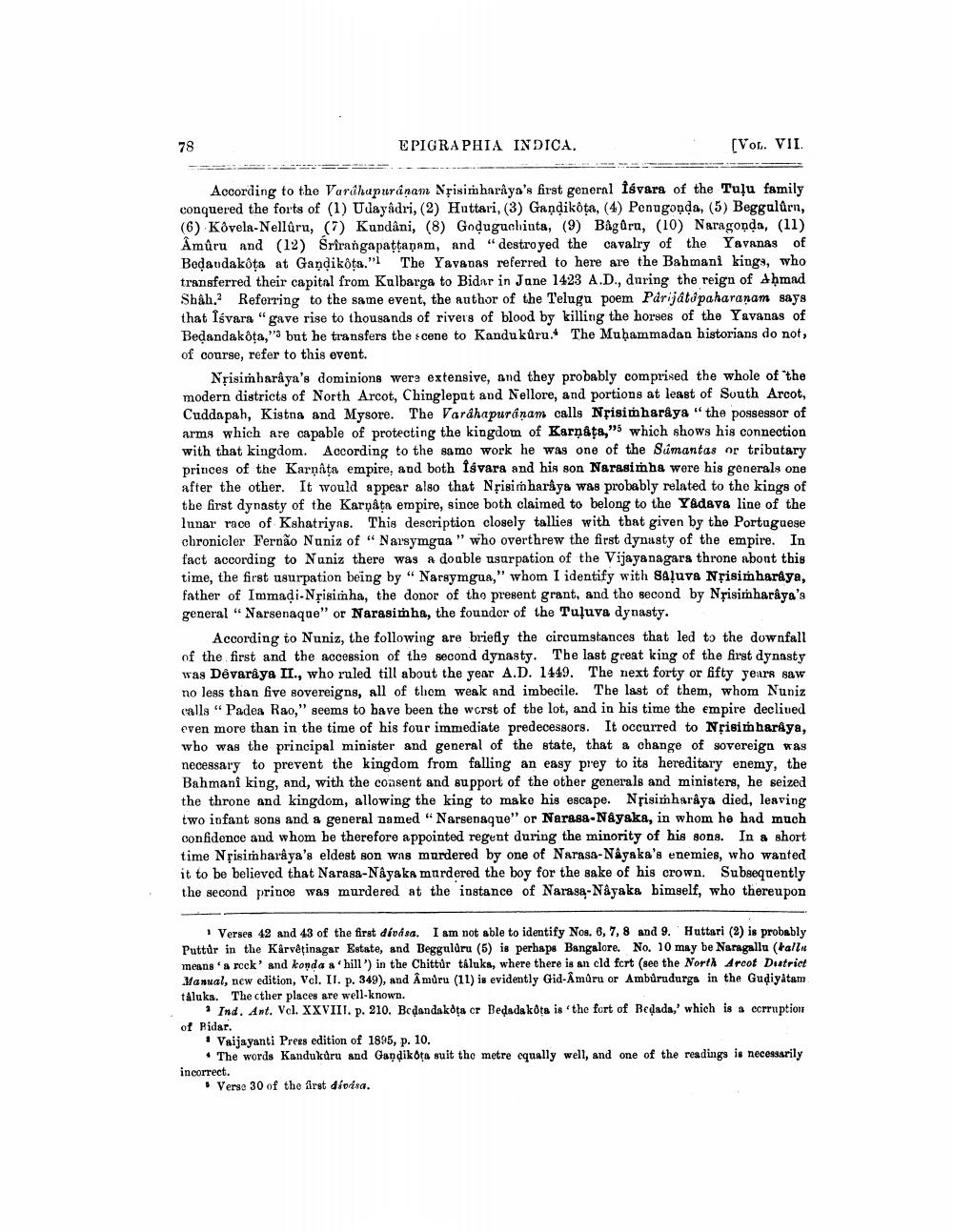________________
78
EPIGRAPHIA INDICA.
[VOL. VII.
According to the Vardhapuranam Nrisimharâya's first general isvara of the Tulu family conquered the forts of (1) Udayâdri, (2) Huttari, (3) Gandikôța, (4) Penugonda, (5) Beggalûrn, (6) Kôvela-Nellûru, (7) Kundâni, (8) Goḍuguchinta, (9) Bâguru, (10) Naragonda, (11) Âmûru and (12) Srirangapaṭṭanam, and "destroyed the cavalry of the Yavanas of Beḍaudakota at Gandikota." The Yavanas referred to here are the Bahmani kings, who transferred their capital from Kulbarga to Bidar in Jane 1423 A.D., during the reign of Aḥmad Shah. Referring to the same event, the author of the Telugu poem Parijatapaharanam says that Isvara "gave rise to thousands of rivers of blood by killing the horses of the Yavanas of Beḍandakota," but he transfers the scene to Kandukuru. The Muḥammadan historians do not, of course, refer to this event.
Nrisimharâya's dominions were extensive, and they probably comprised the whole of "the modern districts of North Arcot, Chingleput and Nellore, and portions at least of South Arcot, Cuddapah, Kistna and Mysore. The Vardhapuranam calls Nrisimharâya "the possessor of arms which are capable of protecting the kingdom of Karnata," which shows his connection with that kingdom. According to the same work he was one of the Sumantas or tributary princes of the Karnâța empire, and both isvara and his son Narasimha were his generals one after the other. It would appear also that Nrisim haraya was probably related to the kings of the first dynasty of the Karpâta empire, since both claimed to belong to the Yadava line of the lunar race of Kshatriyas. This description closely tallies with that given by the Portuguese chronicler Fernão Nuniz of "Narsymgua " who overthrew the first dynasty of the empire. In fact according to Nuniz there was a double usurpation of the Vijayanagara throne about this time, the first usurpation being by "Narsymgua," whom I identify with Saluva Nrisimharaya, father of Immaḍi-Nrisimha, the donor of the present grant, and the second by Nrisimharâya's general "Narsenaque" or Narasimha, the founder of the Tuluva dynasty.
According to Nuniz, the following are briefly the circumstances that led to the downfall of the first and the accession of the second dynasty. The last great king of the first dynasty was Devaraya II., who ruled till about the year A.D. 1449. The next forty or fifty years saw no less than five sovereigns, all of them weak and imbecile. The last of them, whom Nuniz calls"Padea Rao," seems to have been the worst of the lot, and in his time the empire declined even more than in the time of his four immediate predecessors. It occurred to Nrisim haraya, who was the principal minister and general of the state, that a change of sovereign was necessary to prevent the kingdom from falling an easy prey to its hereditary enemy, the Bahmanî king, and, with the consent and support of the other generals and ministers, he seized the throne and kingdom, allowing the king to make his escape. Nrisimharâya died, leaving two infant sons and a general named "Narsenaque" or Narasa-Nayaka, in whom he had much confidence and whom he therefore appointed regent during the minority of his sons. In a short time Nrisimharaya's eldest son was murdered by one of Narasa-Nayaka's enemies, who wanted it to be believed that Narasa-Nayaka murdered the boy for the sake of his crown. Subsequently the second prince was murdered at the instance of Narasa-Nayaka himself, who thereupon
1 Verses 42 and 43 of the first dívása. I am not able to identify Nos. 6, 7, 8 and 9. Huttari (2) is probably Puttür in the Kârvêtinagar Estate, and Beggulûru (5) is perhaps Bangalore. No. 10 may be Naragallu (kalln means a rock' and konda a 'hill') in the Chittür taluks, where there is an cld fcrt (see the North Arcot District Manual, new edition, Vol. II. p. 349), and Âmůru (11) is evidently Gid-Amůru or Ambûrudurga in the Gudiyatam taluka. The cther places are well-known.
Ind. Ant. Vol. XXVIII. p. 210. Bedandakota or Bedadakota is the fort of Bedada,' which is a corruption of Pidar.
Vaijayanti Press edition of 1895, p. 10.
The words Kandukuru and Gandikota suit the metre equally well, and one of the readings is necessarily
incorrect.
Verse 30 of the first divisa.




